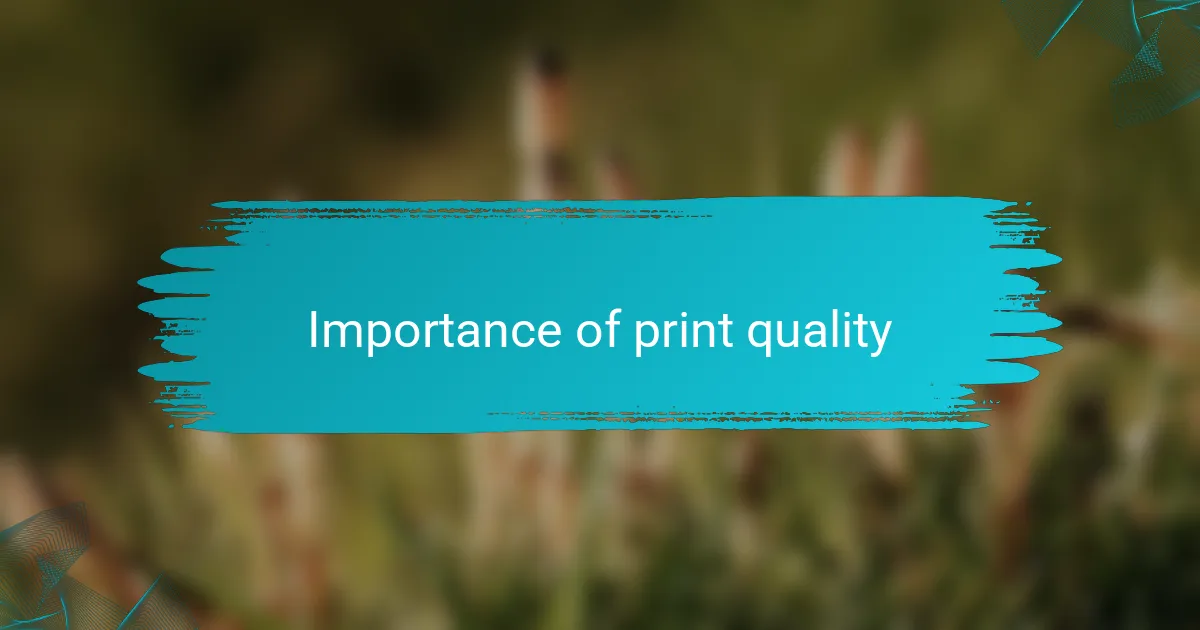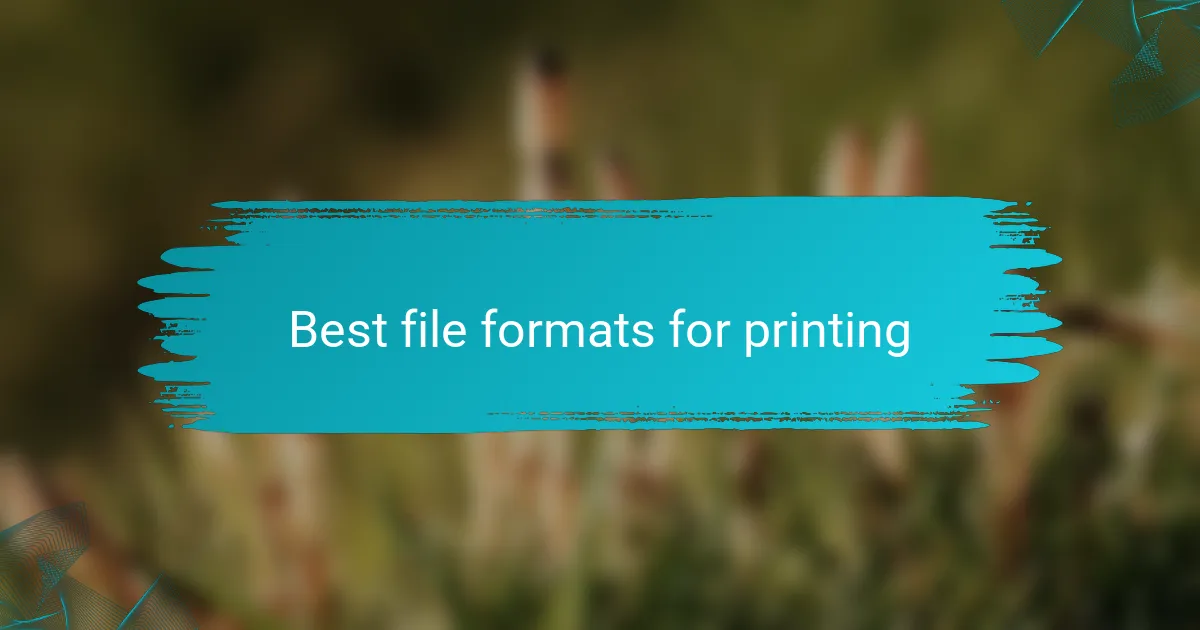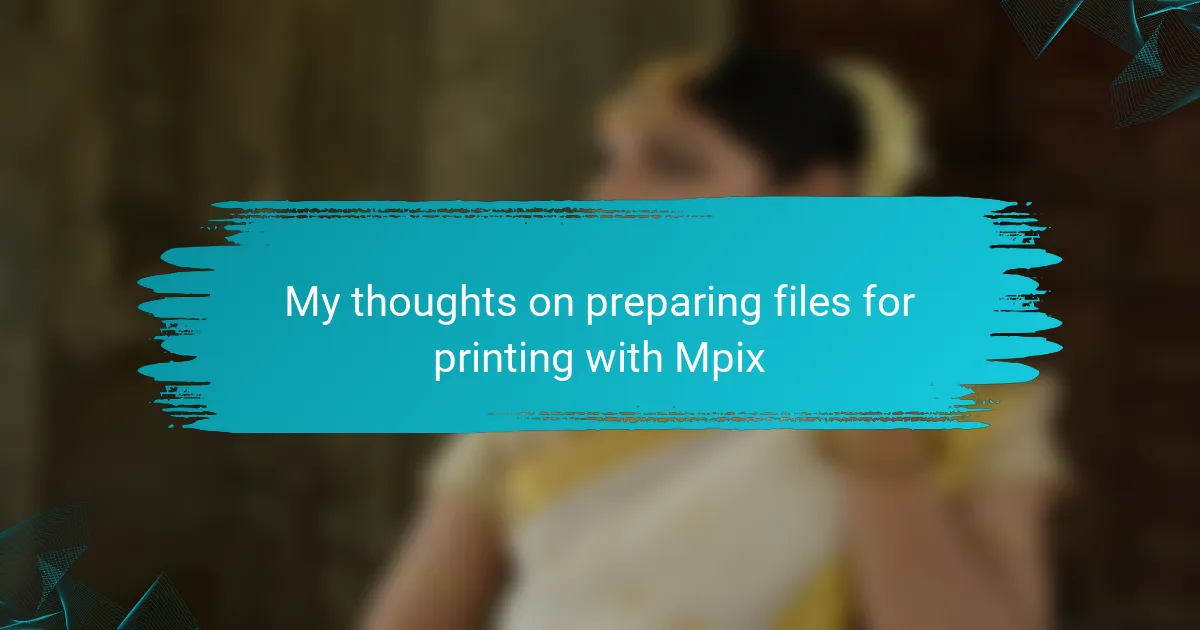Key takeaways
- Preparation is key: Ensure images are at least 300 DPI and use JPEG format for optimal print quality.
- Print quality is essential: Factors such as color accuracy, durability, and detail retention enhance the overall experience of printed memories.
- Color management through calibration and soft proofing significantly improves final print results.
- Utilize Mpix’s tools and customer service to ensure a smooth printing process and high-quality outputs.

Understanding file preparation
When it comes to preparing files for printing with Mpix, understanding the basics of file preparation is essential. I’ve learned that the right resolution and color profile can make a significant difference in the final print quality. For instance, I always ensure my images are at least 300 DPI (dots per inch) to avoid any disappointment when the prints arrive.
Another critical aspect is the file format. I prefer using JPEG for prints because it balances quality and file size effectively. I’ve had times where I mistakenly uploaded PNG files, only to find that they didn’t translate well into the printed medium. Trust me, learning these nuances can save you from heartache and ensure your photos reflect the beauty of the day.
| Aspect | Details |
|---|---|
| Resolution | Minimum 300 DPI for optimal print quality |
| Color Profile | Use Adobe RGB or sRGB for accurate colors |
| File Format | JPEG is ideal for prints; avoid PNG for this purpose |

Importance of print quality
When it comes to wedding photography, the importance of print quality cannot be overstated. I still remember the first time I held a beautifully printed wedding album in my hands. There’s something magical about that tactile experience, one that transports me back to the emotions of the day. A high-quality print not only captures the colors and details of the moment but also preserves the feelings tied to that memory.
Investing time and effort into ensuring your prints are top-notch can make a significant difference. A vibrant, well-crafted print tells a story every time you glance at it, making it a cherished keepsake. Consider these key factors when thinking about print quality:
- Color accuracy ensures that what you captured matches the true essence of the moment.
- Durability means your prints can withstand the test of time, becoming family heirlooms.
- Detail retention allows you to see every nuance, from the delicate lace on the dress to the joy in the couple’s smiles.
- Texture and finish enhance the overall aesthetic and feel of the print, adding an extra layer of depth.
- Paper quality affects longevity and presentation, with options like matte or glossy finishes influencing how images are perceived.

Best file formats for printing
When preparing files for printing with Mpix, choosing the right file format is essential to ensure the highest quality prints. I’ve personally found that TIFF files are my go-to, as they retain the most detail and color information, allowing my wedding photos to shine. With their uncompressed nature, images come through with stunning clarity, capturing the emotion of those precious moments.
On the other hand, JPEGs can be convenient due to their smaller file sizes, but they come with compression that might lose some subtle details. For me, crucial shots, like a couple’s first dance, deserve the best format to fully express the joy and intimacy of the moment. Here’s a breakdown of the best file formats for printing:
- TIFF: Retains maximum detail and color accuracy; ideal for high-quality prints.
- JPEG: Smaller file size, but with some loss in quality; good for casual prints.
- PNG: Useful for images with transparent backgrounds; not ideal for standard prints.
- PDF: Great for multi-page documents, but less common for single photo prints.
Choosing the right format can profoundly impact how memories are preserved and shared, so I always think carefully about each image I print.

Color management for photographs
Color management is an essential part of preparing photographs for print. From my experience, working with the right color profile dramatically influences how the final image appears. I often opt for Adobe RGB when editing my photos because it offers a wider gamut of colors compared to sRGB. This makes sure the vibrant hues in the wedding details come to life when printed. Have you ever noticed how some prints just pop with color, while others fall flat? That could very well be due to the color space used during editing.
It’s fascinating to see how minor adjustments can lead to remarkable differences in print. After a few trials, I’ve learned that calibrating my monitor ensures the colors I see while editing are the colors I get in print. There’s a certain satisfaction in holding a print that mirrors the colors and emotions I captured, especially when it’s from a special day like a wedding. If you haven’t calibrated your monitor yet, I highly recommend it. It’s one of those small steps that can yield significant results.
I also firmly believe in the power of soft proofing. It’s a technique that allows you to simulate how your image will look when printed, based on the printer’s color profile. I remember the first time I used this – I was amazed at how many adjustments I could make before sending the files off to Mpix. It’s like fine-tuning a musical piece before the big concert, ensuring every note resonates perfectly. Using soft proofing has helped me avoid unpleasant surprises, and I can’t stress enough how it elevates the printing experience. What are your thoughts on soft proofing? Have you tried it yet?

Tips for using Mpix services
When using Mpix for printing, my top tip is to always check the resolution of your images. I remember the first time I submitted my photos without verifying this, and I was shocked to see how my beautiful images looked pixelated in print. Ensuring your images are at least 300 dpi guarantees that they will look crisp and vibrant, just like they did on your screen.
Here are some additional tips to enhance your experience with Mpix:
- Use the proper color profile (sRGB is typically recommended) for accurate color reproduction.
- Keep an eye on the print size to maintain your intended composition; cropping can alter your vision.
- Take advantage of Mpix’s online tools, like their print preview, to visualize how your final product will look.
- Order samples if you’re unsure about paper quality; I found that holding the different textures helped me choose what truly represented my work best.
- Lastly, don’t hesitate to reach out to their customer service for any questions; they have been incredibly helpful in guiding me through the process.

My personal experience with Mpix
My experience with Mpix has been largely positive, transforming the way I handle print orders. I still remember the first time I received a package from them. The excitement surged through me as I opened it to uncover stunning prints of a couple’s wedding day. Seeing those images come to life was a powerful reminder of why I love wedding photography in the first place.
Every time I upload files to Mpix, I make it a point to double-check everything. Once, I submitted an order without paying attention to the color profile, and the prints didn’t match what I saw on my screen. It’s moments like these that teach you the importance of meticulous preparation. Have you ever had a similar mishap with prints? That experience taught me to always ensure I’m using sRGB for prints to capture those vibrant colors accurately.
One aspect that stands out for me with Mpix is their user-friendly interface, which makes the ordering process feel seamless. I appreciate how quickly I can select my images, choose the print sizes, and finalize my order. There’s a certain comfort in knowing I can rely on them for quality – it feels like I have a trusted partner backing up my work. Every print reminds me of the joy of that special day, and I cherish the crafted memories they help me create.
